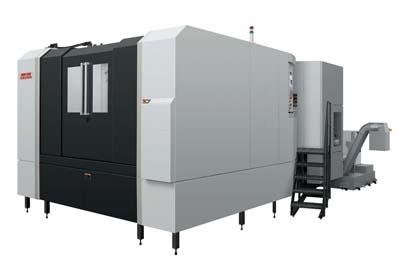
Mori Seiki Co. Ltd. has announced the debut of the NH10000DCG machine tool. The NH10000DCG is the newest and largest model in Mori Seiki's lineup of high-speed, high-precision horizontal machining centers. In recent years, the need for machine tools that achieve higher levels of efficiency and precision has been increasing as the demand for high-efficiency and high-precision machining of large parts and difficult-to-cut materials used in the construction machinery, aircraft and printing equipment industries has been growing. In anticipation of this need, Mori Seiki has developed the NH10000DCG. The NH Series has achieved over 6,000 unit orders since the release of the NH5000DCG in August 2002. In contrast to the NH4000DCG and NH5000DCG machine models, the NH10000DCG can handle a maximum workpiece size of φ 2,000mm x 1,600mm and a maximum loading capacity of 3,000 kg (5,000 kg as option). The NH Series machines are designed to facilitate setup operations, including the center alignment of a workpiece. The height difference between inside and outside of the NH10000DCG has been eliminated by installing work platforms. Additionally, by using the setup station, large working area and wide door opening, the machine offers improved operability and accessibility. The NH10000DCG uses Box-in-Box Construction, which supports the saddle at both sides; the center of gravity of the moving parts is guided and driven with excellent balance despite its large structure. It also achieves roundness of 2.12μm by minimizing residual tool tip vibration during positioning and by improving machined surface quality. On the X and Z linear axes, it benefits from DCG original technology (Driven at the Center of Gravity) by driving moving parts at their center of gravity using two ballscrews, hence controlling vibration. The NH10000DCG achieves rapid traverse rate of 50 m/min. New features of this NH Series model include an all-new coolant evacuation function, available for through-spindle coolant specifications. Coolant that is left in the spindle is vacuumed into the tank when coolant stops flowing. This prevents the residual coolant from adhering to the spindle taper and being carried into the tool magazine during ATC tool changing. With this function, long-term problems caused by coolant can be avoided, ensuring stable machining accuracy. Additionally, the machine is equipped with three spiral conveyors to offer excellent chip disposal. These conveyors, two of which extend to the setup station, collect chips and coolant not only from the machining area but also from the setup station and transfer them to the external conveyor. The NH10000DCG is suitable for machining long workpieces. An expanded tool magazine is available as an option and has the capacity of storing tools up to 1,000mm. The use of long tools enables the performance of deep-hole boring and gundrilling of large workpieces that require accurate coaxiality without a 180-degree turn on the B-axis, achieving reduced cutting time and high precision machining. With a maximum loading capacity of 5,000 kg (option), which is the largest among Mori Seiki horizontal machining centers, the NH10000DCG has the optional automatic indexing setup station that allows automatic rotation of heavy workpieces.
Contact Details
Related Glossary Terms
- boring
boring
Enlarging a hole that already has been drilled or cored. Generally, it is an operation of truing the previously drilled hole with a single-point, lathe-type tool. Boring is essentially internal turning, in that usually a single-point cutting tool forms the internal shape. Some tools are available with two cutting edges to balance cutting forces.
- centers
centers
Cone-shaped pins that support a workpiece by one or two ends during machining. The centers fit into holes drilled in the workpiece ends. Centers that turn with the workpiece are called “live” centers; those that do not are called “dead” centers.
- coolant
coolant
Fluid that reduces temperature buildup at the tool/workpiece interface during machining. Normally takes the form of a liquid such as soluble or chemical mixtures (semisynthetic, synthetic) but can be pressurized air or other gas. Because of water’s ability to absorb great quantities of heat, it is widely used as a coolant and vehicle for various cutting compounds, with the water-to-compound ratio varying with the machining task. See cutting fluid; semisynthetic cutting fluid; soluble-oil cutting fluid; synthetic cutting fluid.
- gundrilling
gundrilling
Drilling process using a self-guiding tool to produce deep, precise holes. High-pressure coolant is fed to the cutting area, usually through the gundrill’s shank.
- precision machining ( precision measurement)
precision machining ( precision measurement)
Machining and measuring to exacting standards. Four basic considerations are: dimensions, or geometrical characteristics such as lengths, angles and diameters of which the sizes are numerically specified; limits, or the maximum and minimum sizes permissible for a specified dimension; tolerances, or the total permissible variations in size; and allowances, or the prescribed differences in dimensions between mating parts.
- rapid traverse
rapid traverse
Movement on a CNC mill or lathe that is from point to point at full speed but, usually, without linear interpolation.

